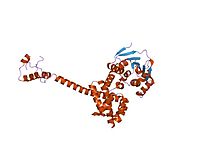

| Cdc37 N terminal kinase binding | |||||||||
|---|---|---|---|---|---|---|---|---|---|
| Identifiers | |||||||||
| Symbol | CDC37_N | ||||||||
| Pfam | PF03234 | ||||||||
| InterPro | IPR013855 | ||||||||
| SCOP2 | 1us7 / SCOPe / SUPFAM | ||||||||
| |||||||||
| Cdc37 Hsp90 binding domain | |||||||||
|---|---|---|---|---|---|---|---|---|---|

complex of hsp90 and p50
| |||||||||
| Identifiers | |||||||||
| Symbol | CDC37_M | ||||||||
| Pfam | PF08565 | ||||||||
| InterPro | IPR013874 | ||||||||
| SCOP2 | 1us7 / SCOPe / SUPFAM | ||||||||
| |||||||||
| Cdc37 C terminal domain | |||||||||
|---|---|---|---|---|---|---|---|---|---|

complex of hsp90 and p50
| |||||||||
| Identifiers | |||||||||
| Symbol | CDC37_C | ||||||||
| Pfam | PF08564 | ||||||||
| InterPro | IPR013873 | ||||||||
| SCOP2 | 1us7 / SCOPe / SUPFAM | ||||||||
| |||||||||
Hsp90 co-chaperone Cdc37 is a protein that in humans is encoded by the CDC37 gene.[5] This protein is highly similar to Cdc 37, a cell division cycle control protein of Saccharomyces cerevisiae. This protein is a HSP90 Co-chaperone[6] with specific function in cell signal transduction. It has been shown to form complex with Hsp90 and a variety of protein kinases including CDK4, CDK6, SRC, RAF1, MOK, as well as eIF-2 alpha kinases. It is thought to play a critical role in directing Hsp90 to its target kinases.[7]
CDC37 has been shown to interact with:
CDC37 consists of three structural domains. The N-terminal domain binds to protein kinases.[16] The central domain is the Hsp90 chaperone (heat shock protein 90) binding domain.[17] The function of the C-terminal domain is unclear.